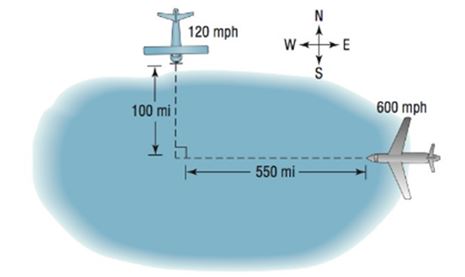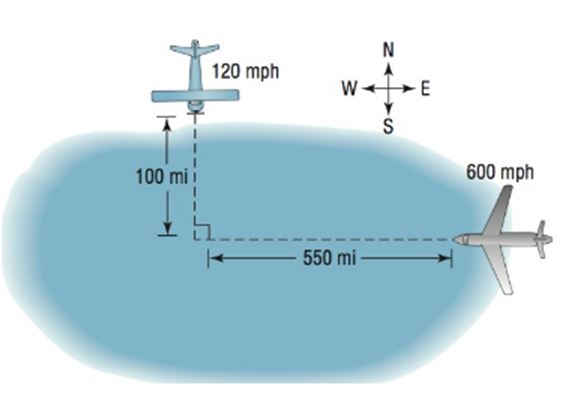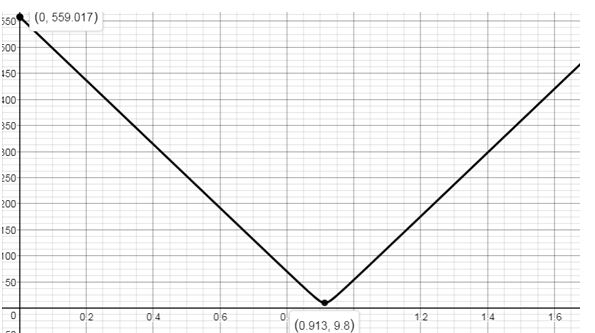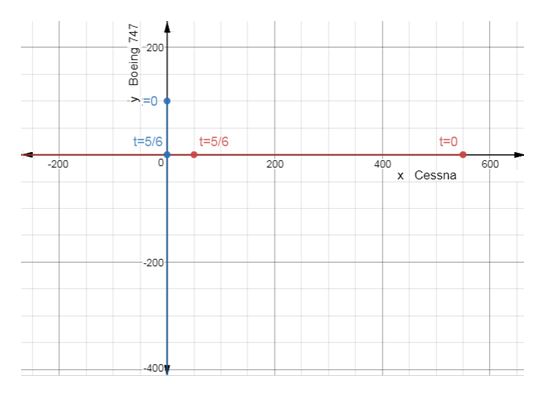
Concept explainers
Uniform Motion A Cessna (heading south at 120 mph) and a Boeing 747 (heading west at 600 mph) are flying toward the same point at the same altitude. The Cessna is 100 miles from the point where the flight patterns intersect, and the 747 is 550 miles from this intersection point. See the figure.

a. Find parametric equations that model the motion of the Cessna and the 747.
b. Find a formula for the distance between the planes as a function of time.
c. Graph the function in part (b) using a graphing utility.
d. What is the minimum distance between the planes? When are the planes closest?
e. Simulate the motion of the planes by simultaneously graphing the equations found in part (a).
To find:
a. parametric equations that model the motion of the Cessna and the 747.
Answer to Problem 58AYU
a. Boeing 747: ; Cessna: ,
Explanation of Solution
Given:
A Cessna (heading south at 120 mph) and a Boeing 747 (heading west at 600 mph) are flying toward the same point at the same altitude. The Cessna is 100 miles from the point where the flight patterns intersect, and the 747 is 550 miles from this intersection point.

Calculation:
a. At ,
Cessna is at a distance of 100 miles from intersection and is travelling south at a speed of 120 mph.
Parametric equation for Cessna:
,
At ,
Boeing 747 is 550 miles from the intersection and is travelling west at a speed of 600mph.
Parametric equation for Boeing 747:
,
To find:
b. A formula for the distance between the planes as a function of time.
Answer to Problem 58AYU
b.
Explanation of Solution
Given:
A Cessna (heading south at 120 mph) and a Boeing 747 (heading west at 600 mph) are flying toward the same point at the same altitude. The Cessna is 100 miles from the point where the flight patterns intersect, and the 747 is 550 miles from this intersection point.

Calculation:
b. As per the given figure we can use Pythagoras theorem to find the distance in terms of
To find:
c. Graph the function in part (b) using a graphing utility.
Answer to Problem 58AYU
c.

Explanation of Solution
Given:
A Cessna (heading south at 120 mph) and a Boeing 747 (heading west at 600 mph) are flying toward the same point at the same altitude. The Cessna is 100 miles from the point where the flight patterns intersect, and the 747 is 550 miles from this intersection point.

Calculation:
c. Graph the function in part c

To find:
d. What is the minimum distance between the planes? When are the planes closest? Simulate the motion of the planes by simultaneously graphing the equations found in part (a).
Answer to Problem 58AYU
d. Distance between the cars is miles. At hours, the cars are closer to each other.

Explanation of Solution
Given:
A Cessna (heading south at 120 mph) and a Boeing 747 (heading west at 600 mph) are flying toward the same point at the same altitude. The Cessna is 100 miles from the point where the flight patterns intersect, and the 747 is 550 miles from this intersection point.

Calculation:
d. From the graph above the minimum distance between the planes is miles. At hours, the planes are closer to each other.

Chapter 10 Solutions
Precalculus Enhanced with Graphing Utilities
Additional Math Textbook Solutions
Elementary Statistics
Algebra and Trigonometry (6th Edition)
College Algebra (7th Edition)
Calculus for Business, Economics, Life Sciences, and Social Sciences (14th Edition)
Pre-Algebra Student Edition
- Find three horizontal tangents between [0,10]arrow_forward4 In the integral dxf1dy (7)², make the change of variables x = ½(r− s), y = ½(r + s), and evaluate the integral. Hint: Find the limits on r and s by sketching the area of integration in the (x, y) plane along with the r and s axes, and then show that the same area can be covered by s from 0 to r and r from 0 to 1.arrow_forward7. What are all values of 0, for 0≤0<2л, where 2 sin² 0=-sin? - 5π 6 π (A) 0, л, and 6 7π (B) 0,л, 11π , and 6 6 π 3π π (C) 5π 2 2 3 , and π 3π 2π (D) 2' 2'3 , and 3 4元 3 1 די } I -2m 3 1 -3 บ 1 # 1 I 3# 3m 8. The graph of g is shown above. Which of the following is an expression for g(x)? (A) 1+ tan(x) (B) 1-tan (x) (C) 1-tan (2x) (D) 1-tan + X - 9. The function j is given by j(x)=2(sin x)(cos x)-cos x. Solve j(x) = 0 for values of x in the interval Quiz A: Topic 3.10 Trigonometric Equations and Inequalities Created by Bryan Passwaterarrow_forward
- can you solve this question using partial fraction decomposition and explain the steps used along the wayarrow_forwardIntegral How 80*1037 IW 1012 S е ऍ dw answer=0 How 70+10 A 80*1037 Ln (Iwl+1) du answer=123.6K 70*1637arrow_forwardcan you solve this question and explain the steps used along the wayarrow_forward
 Calculus: Early TranscendentalsCalculusISBN:9781285741550Author:James StewartPublisher:Cengage Learning
Calculus: Early TranscendentalsCalculusISBN:9781285741550Author:James StewartPublisher:Cengage Learning Thomas' Calculus (14th Edition)CalculusISBN:9780134438986Author:Joel R. Hass, Christopher E. Heil, Maurice D. WeirPublisher:PEARSON
Thomas' Calculus (14th Edition)CalculusISBN:9780134438986Author:Joel R. Hass, Christopher E. Heil, Maurice D. WeirPublisher:PEARSON Calculus: Early Transcendentals (3rd Edition)CalculusISBN:9780134763644Author:William L. Briggs, Lyle Cochran, Bernard Gillett, Eric SchulzPublisher:PEARSON
Calculus: Early Transcendentals (3rd Edition)CalculusISBN:9780134763644Author:William L. Briggs, Lyle Cochran, Bernard Gillett, Eric SchulzPublisher:PEARSON Calculus: Early TranscendentalsCalculusISBN:9781319050740Author:Jon Rogawski, Colin Adams, Robert FranzosaPublisher:W. H. Freeman
Calculus: Early TranscendentalsCalculusISBN:9781319050740Author:Jon Rogawski, Colin Adams, Robert FranzosaPublisher:W. H. Freeman
 Calculus: Early Transcendental FunctionsCalculusISBN:9781337552516Author:Ron Larson, Bruce H. EdwardsPublisher:Cengage Learning
Calculus: Early Transcendental FunctionsCalculusISBN:9781337552516Author:Ron Larson, Bruce H. EdwardsPublisher:Cengage Learning





